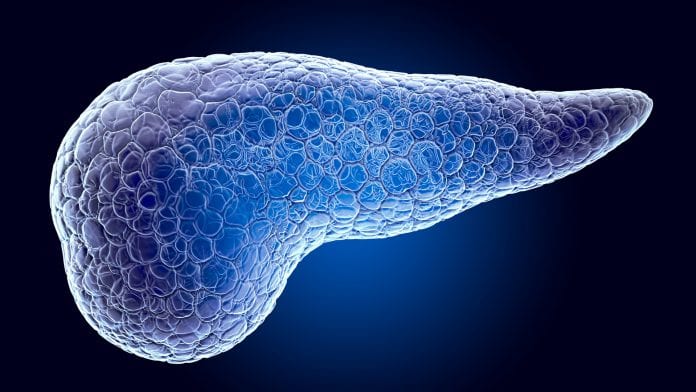
A new biomarker – a protein called pentraxin 3 (PTX3) – has been identified that could be used to aid in the diagnosis of pancreatic cancer.
Researchers from Queen Mary University of London have identified the protein which the team say may be a specific diagnostic biomarker for pancreatic cancer, with the ability to differentiate pancreatic cancer from other non-cancerous conditions of the pancreas.
The research was published in npj Precision Oncology, and funded by the Pancreatic Cancer Research Fund, Barts Charity, and Cancer Research UK.
PTX3 levels
The team measured PTX3 levels in serum blood samples from patients with pancreatic ductal adenocarcinoma (PDAC) and from healthy volunteers or patients with other non-cancerous conditions of the pancreas. They found that levels of the protein were significantly higher in the serum samples of those with PDAC.
These patients also had notably higher serum PTX3 levels than those with intra-ductal papillary mucinous neoplasm or chronic pancreatitis – two non-cancerous conditions that often present with similar symptoms to PDAC, making a definitive diagnosis more difficult.
Hemant Kocher, Professor of Liver and Pancreas surgery at Queen Mary University of London and consultant at Barts Health NHS Trust, who led the study, said: “In the clinic, computerised tomography (CT) scanning is usually used in the diagnosis of pancreatic cancer. Although CT can detect the presence of a pancreatic mass, it cannot distinguish pancreatic cancer from other non-cancerous pancreatic diseases. This poses frequent diagnostic dilemmas in clinical practice, and there are currently no clinically applicable biomarkers for the early detection of PDAC.
“The findings from our study suggest that PTX3 could be used as a biomarker to improve PDAC diagnosis, and warrants further testing to determine whether it could aid early detection of PDAC in the clinic.”
Non-cancerous cells
Most cancer biomarkers that are used in clinical practice are proteins released from the cancer cells themselves. Unfortunately, with PDAC, one of the defining features is that there are very few cancer cells. Pancreatic cancer is made up of mostly non-cancer cells, which have been co-opted by cancer to build a huge amount of scar tissue or stroma around the cancer.
PTX3 is released from non-cancerous cells such as stellate cells (star shaped cells) that surround the pancreatic tumour.
By looking at data from clinical trials, the team found that when pancreatic cancer alone is targeted, PTX3 does not seem to change upon administration of chemotherapy; however, when medications targeting both cancer and stroma are administered, changes are seen in PTX3 levels, which can be easily measured in blood to monitor how the drug is working. Thus, PTX3 may help in monitoring the effectiveness of treatment much earlier than scans may be able to indicate treatment response.
The findings from this study suggest that PTX3 may be a sensitive and specific biomarker able to distinguish cancerous from non-cancerous conditions of the pancreas, and the team hope they will provide direction for future prospective clinical trials to determine whether PTX3 could be effective in the clinic as a biomarker for early detection and used in conjunction with other biomarkers to monitor response to treatment of pancreatic cancer.







